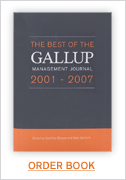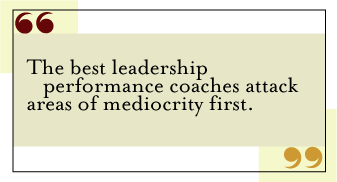To understand a big problem with executive coaching, let's start by replaying a recent conversation between a management consultant and an executive coach:
Consultant: "What does executive coaching involve?"
 |
Executive Coach: "I get to work one-on-one with senior-level executives in different organizations."
Consultant: "Yes, but what do you actually do?"
Executive Coach: "I get paid to coach them, to sort of help them. It's difficult to describe."
Consultant: "What kind of coaching do you do?"
Executive Coach: "I try to help leaders discover themselves, to encourage them, to make them feel better about their work, to keep their spirits up. They have a tough job, and I just try to make it a little easier for them."
Consultant: "How do you know you're making a difference?"
Executive Coach: "Well, the leaders I work with say that they feel better when I help them, and they keep asking me back."
Consultant: "No, I meant, are you able to measure the difference you are making? Do major numbers shift as a result of your work? What scores do you track?"
Executive Coach: "Look, my work is far too important to reduce to numbers. I help leaders grow. If they want numbers, they should ask an accountant!"
Sadly, in the growing field of executive coaching, exchanges like this are common. A cadre of well-intentioned coaches peddles their wares in a "feel-good" market that caters to the upper echelons of corporate America. Coaches like these are able to make a healthy living by providing a "solution" to a perceived gap between senior managers' development needs and their businesses' needs. They work closely with leaders and develop strong, long-lasting relationships that endure. The problem is, the results just might not make a difference for the leaders' businesses.
 |
My own extensive experience of working with top executives reveals that coaching that focuses on business performance is key to improvement in executive performance. The contrast between a "feel-good" approach and one that is candid, objective, and incisive, is stark. As executives search to address their vulnerabilities by seeking out an independent voice, feel-good feedback can give them a nice emotional boost, but the results may leave them wondering whether it was worth it. For some, feeling good becomes synonymous with feeling comfortable.
Understand the business strategy
What sets performance coaching apart from feel-good coaching? What should leaders consider before embarking on what could be either a lifelong business-building relationship or an expensive journey toward mediocrity?
First, a productive performance coaching relationship shouldn't start with an analysis of the individual leader. Instead, it should begin with an evaluation of the leader's business goals and responsibilities. Coaches must possess more than business or market savvy. They also must grasp the specific short-term and medium-term business issues that the executive faces.
The best executive performance coaches start a coaching relationship with a careful analysis of the company's business strategy. Then, they help leaders get specific and real in translating big ideas to ground-level activity. Step-by-step, they work with executives to understand and develop the measures and numbers that must be achieved to attain significant performance outcomes.
A real-life example illustrates how this process should work. In mid-2004, an executive took over a global product development team for a multinational manufacturer. Upon assuming this new role, he said that the last thing he needed was to have his head filled with big ideas.
"I have goals to meet, and I just need help with three things," he said. "First, our overall product market is declining. I have to source and then develop new product to achieve 5% growth targets in 2005. Second, this team costs too much for its current productivity. I have to cut headcount and increase per-person productivity by at least 12%. Third, this team operates in silos, and we are missing too many cross-selling opportunities. I have goals to expand our product ratios in our top five markets from 5:1 to 3:1 by the end of the fiscal year." For this executive, improving ratios means equalizing the balance of sales between two products through better cross-selling, while continuing to grow overall revenue.
Once his leadership performance coach understood the executive's business goals, the coach could use that knowledge to push and guide him toward meeting them. In this example, deftly deploying and managing personnel would be key to his success. His coach asked questions like: Who is best to position where? Who has the talent to succeed? What do you need to communicate, and when?
The best performance coaches help leaders connect the future to the present by breaking down the steps that lead toward success. Then, they help leaders think through the implications of their decisions and actions. Coaches should help leaders anticipate and strategize by presenting alternatives, taking the contrary view, articulating the strongest points of resistance, and connecting the leader with external experiences and insights.
Know the leader's strengths and weaknesses
Once the performance coach has a firm grasp of the business and where it's going, the next step is to understand the strengths and weaknesses of the leader and the teams with which she works. What does she do best? What innate talents can she leverage? What blind spots might prevent success?
For example, the product development executive above was not cut out to be a slick communicator. He continually stumbled to recover from a stream of inept and ill-timed messages. He tended to over-elaborate information about upcoming meetings; when he finally sent information, it arrived too late for team members to be able to fully consider options. His poor communications threatened to undermine his efforts to meet his team's goals.
 |
To help him overcome this problem, the performance coach had to provide clear analysis of the problem and how it could be solved. After an analysis of team strengths, the coach recommended that the executive delegate the task of handling team communications to a team member who had the most natural talent in this area.
Without insights from his performance coach, this leader would not have reached this decision on his own; in fact, he did not want to let go of the communication responsibilities. Ultimately, his coach persuaded him to make the change by focusing on the desired outcome.
"This team won't reach 12% per-person productivity growth if you keep sending unclear messages immediately before important meetings," the coach said bluntly. "You're better at setting the goals and dealing with customers; get someone else to do the communication."
It turned out to be a smart move because it liberated the leader to focus his efforts on product diversification -- an area in which he excels. In fact, a turnaround in cross-selling growth occurred after the leader delegated his communication responsibilities. Currently, with four months still remaining in his company's fiscal year, the team's product ratios are at 3:1 or better in its top five markets, with growing revenues. His team's employee engagement levels have also increased.
Challenge every assumption
Executive performance coaches who focus more on how leaders feel than on how effectively they perform rarely step into uncomfortable territory. But challenging fundamental assumptions is essential if leaders are to confront obstacles and achieve professional and business growth. Knowing what buttons to push and when requires good judgment -- but the best leadership performance coaches attack areas of mediocrity first. They challenge leaders who want to creep toward goals through incremental gain. They recognize that excellence rarely results when leaders spend too much time doing things they don't do well.
Effective leadership performance coaches drive improvement by challenging leaders to expand their scope of what is possible for the organization to achieve. They might do this by bringing in case studies and benchmarks to help the leader learn and grow. But more often, they start by challenging any assumption -- like the assumption that a 12% growth in per-person productivity is sufficient.
A great executive coach isn't a "Dr. Feelgood." Rather, he or she delivers incisive analysis and brutally honest, detached advice and feedback. Effective coaches -- the kind that really want to help leaders and businesses grow -- use an array of tools and objective assessments to inform their advice. They operate close to the edge of executive tolerance, knowing how far and to what extent to push for change. And they measure their success not by how good they make executives feel, but by how far each leader moves the numbers.